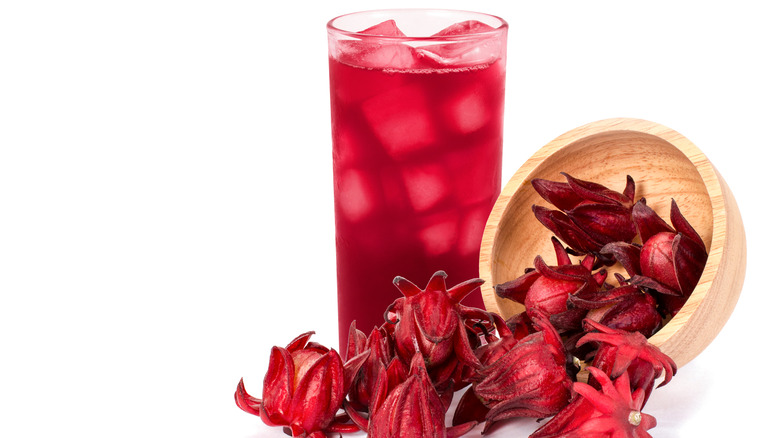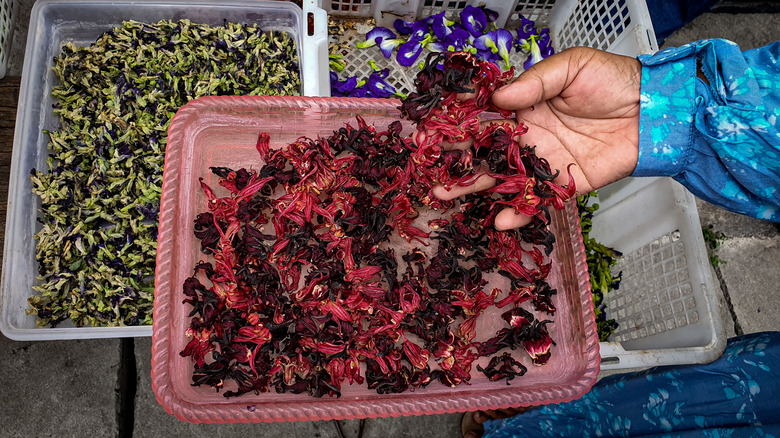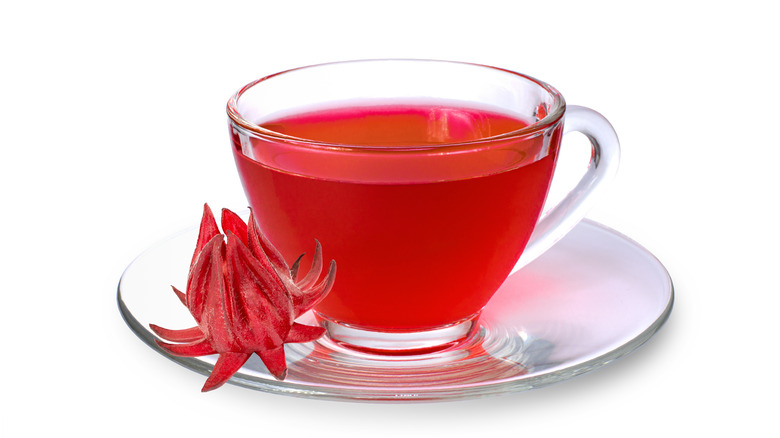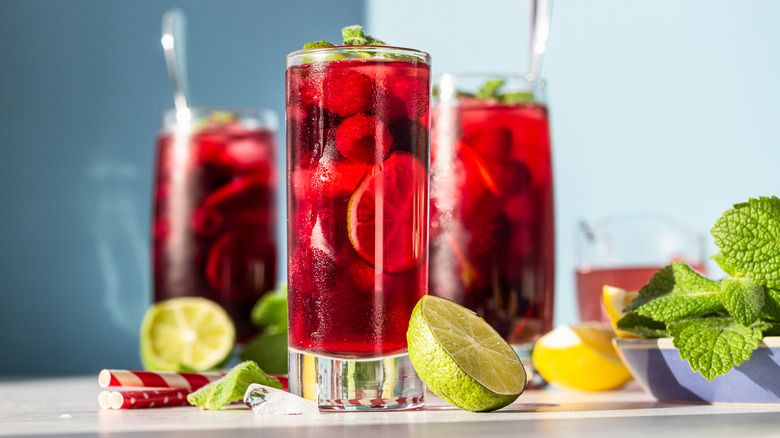What Is Roselle Juice And What Does It Taste Like?
Roselle juice and tea has been around for ages. And the flower from which it is made goes by a laundry list of names depending on where you might be consuming it. Perhaps, the only thing greater than its catalog of names is its varied uses. But if you have never heard of this ruby-red drink or its origins, don't worry. We've got you covered. According to the Garden Lovers Club, the roselle hails from the hibiscus family. Roselle can be called red sorrel, Florida cranberry, or Jamaica sorrel just to give you an idea of its many monikers. Per The Daytona Beach News Journal, the roselle plant mostly grew in West Africa, India, and Malaysia until, in the 1880s, it found its way to the shores of Florida, by way of Jamaica.
The University of Florida Institute of Food and Agriculture explains that the roselle, or Hibiscus sabdariffa, was once as popular to eat as it was to grow for decorative foliage. They describe the flowers as yellow with a dark center but further explain that it is the calyx, which is the dainty and somewhat delicate-looking red cup at the bottom of the flower, where all the seeds are nestled, that is used the most to make beverages and jams. But note, the calyces are picked before they turn brown and the seeds are removed before using in your favorite recipes.
What does roselle juice taste like?
The University of Florida Institute of Food and Agriculture likens roselles to cranberries when it comes to taste. They are sour to the taste buds. When the roselle is made into a liquid, this crimson drink can be served hot or cold as a tea, or you can drink it with alcohol or wine. However, regardless of how it is served, it is generally always sweetened because its tartness can make the mouth pucker. But one fact about this hibiscus beverage that may be surprising is the suggestion that it influenced the creation of other red drinks including every kids' favorite red Kool-Aid and the soft drink Big Red (via First We Feast).
What is truly fascinating about this hibiscus flower is all of its uses. If you find yourself in the Caribbean during the Christmas season, the University of Florida shares that you may even sip on roselle juice in a holly jolly drink. Rhubarb pie lovers can use roselle as a substitute for the stalky vegetable and the seeds of this flower can be dried and used to make coffee or thrown into a salad to add texture and a little protein. The good people of Florida even have a recipe that uses the roselle as an alternative when making cranberry sauce.
Nutritional information about roselle juice
Drinking roselle juice has many health benefits. According to the Daytona Beach News Journal, drinking roselle juice may help relieve menstrual cramps and is an anti-inflammatory. Additionally, it can support a healthy digestive system and may even aid in weight loss. Rhymba Hills Tea shares that this is largely due to the diuretic properties of the roselle's seeds, which also makes it an option when the not-so-fun constipation hits.
Additionally, because roselle is high in vitamin C, it can help boost your immune system. And if you are looking to give your gums and teeth a little extra TLC, roselle is said to help in that area too due to its high calcium content. Roselle juice clearly has some powerhouse properties. But, of course, before you use roselle for any type of medicinal purpose, you should be sure to consult your doctor.
Where to buy and how to store your roselle
Roselle syrup can be purchased from an online retailer like Taste of Aloha where they suggest adding it to a sparkling water to make a tropic tasting cooler. You can find dried roselle tea at everywhere from Whole Foods to Amazon. And Gardening Know How notes that you can buy the seeds online, just search for them using the name "Flor de Jamaica." They also explain the simple process for turning the roselle into a beverage involves, "boiling the Roselle calyces in water, straining this water and adding sugar, spices."
If you grow this annual, University of Florida Institute of Food and Agriculture shares you can grow roselle yourself, particularly in the southern U.S. The flowering plants are generally planted in April and you can pick the calyces in October and November. Once picked, they will stay fresh for about a week, and the site shares you do not have to plant an orchard to get a bountiful hull. One plant can give you up to 12 pounds of these babies. The blog Times Square Garden explains that you can dry your roselles for future use and store them in mason jars in a cool, dry, and dark spot.



